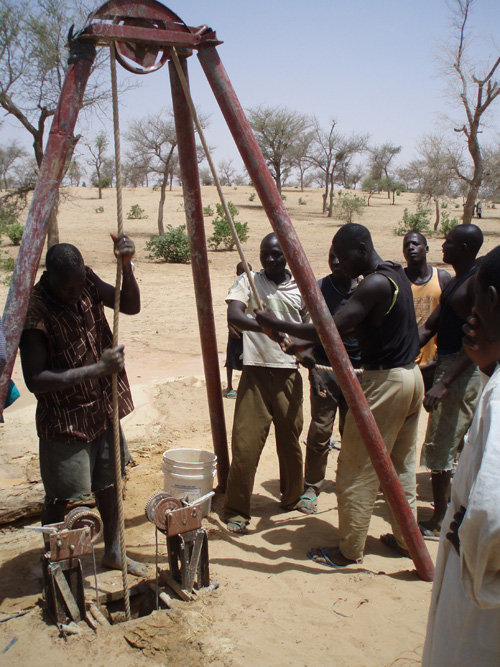Solution of the week 13
Contents
UNICEF goes manual drilling
Guest contributor Arjen van der Wal is an environmentalist and drilling expert at Practica Foundation, an Akvo support partner. Here he describes the opportunities possible when people are trained to drill wells.
Say you want to extract water from the ground, because you have had enough of carrying water around for six hours a day, and have more useful things to do with your time. And say you live in a region where the ground water is of good quality, and the soil consists of sand or clay. Then you might want to have a borehole, preferably near your house, where you can get nice, clean, safe water, without walking too far. What are your options?
Up to now, drilling boreholes involved large and expensive machines, which get the job done quickly and efficiently. Machine drilled wells are very high in quality, but also very expensive. The cost of a machine drilled well varies between countries and will generally be in the range of $5,000 to $15,000 for a 30-meter deep well. Unfortunately, this is so expensive that it is unreachable for almost all poor communities, and needs large subsidies to get done at all. And if large subsidies are needed, it does not scale. But a silent revolution to change all this is underway, and it is called manual drilling.
Manual drilling
Manual drilling does away with big trucks with expensive machinary, and depends entirely on hand-powered equipment and lots of skill. If you don’t have money, you have to be smart! Costs of 30-metre deep wells vary from about $100 to $2,500, depending on geology, country and application (small scale irrigation wells or high quality community wells for potable water). See here and here for earlier blogs on the subject.
Manual drilling itself already exists for hundreds of years, but use by larger organisations has been limited, as the quality of the wells was often questioned. This is now rapidly changing, with large organisations such as Unicef embracing manual drilling as part of their technology portfolio. In the field of water supply, this is no less than revolutionary.
Training, training, training
The most important thing to get manual drilling of the ground in a professional way in a region is training. In a joint effort, the Dutch PRACTICA Foundation, UNICEF, and US-based Enterprise Works/Vita have developed a toolkit for African countries wishing to embark on the professionalisation of manual drilling. This toolkit includes technical notes, technical manuals, advocacy materials, mapping of suitable areas for manual drilling, case studies, and implementation and training manuals. The works. With this material, the local private sector can take up manual drilling, so they can respond to the ever-increasing demand for safe water in rural areas.
Our experience at PRACTICA has been that with the right training of manual drilling teams, wells of good quality can be drilled. In Chad for example, UNICEF and PRACTICA are training 43 manual drilling enterprises, quality controllers and pump repairman, ultimately producing over 500 wells for rural communities. Case study: The impact of manual drilling for the construction of sustainable water-points in Chad.
Read and see more
- 5 technical notes.
- Professionalizing the Manual Drilling Sector in Africa: A Guide to Building Capacity to Increase Access to Safe Water in Rural Areas.
Author: Arjen van der Wal, Practica Foundation. Practica Foundation is a partner of Akvo: Practica RSR Projects.

